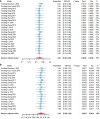Minocycline in the eradication of Helicobacter pylori infection: A systematic review and meta-analysis
- PMID: 38813048
- PMCID: PMC11130572
- DOI: 10.3748/wjg.v30.i17.2354
Minocycline in the eradication of Helicobacter pylori infection: A systematic review and meta-analysis
Abstract
Background: Difficulty in obtaining tetracycline, increased adverse reactions, and relatively complicated medication methods have limited the clinical application of the classic bismuth quadruple therapy. Therefore, the search for new alternative drugs has become one of the research hotspots. In recent years, minocycline, as a semisynthetic tetracycline, has demonstrated good potential for eradicating Helicobacter pylori (H. pylori) infection, but the systematic evaluation of its role remains lacking.
Aim: To explore the efficacy, safety, and compliance of minocycline in eradicating H. pylori infection.
Methods: We comprehensively retrieved the electronic databases of PubMed, Embase, Web of Science, China National Knowledge Infrastructure, SinoMed, and Wanfang database as of October 30, 2023, and finally included 22 research reports on H. pylori eradication with minocycline-containing regimens as per the inclusion and exclusion criteria. The eradication rates of H. pylori were calculated using a fixed or a random effect model, and the heterogeneity and publication bias of the studies were measured.
Results: The single-arm meta-analysis revealed that the minocycline-containing regimens achieved good overall H. pylori eradication rates, reaching 82.3% [95% confidence interval (CI): 79.7%-85.1%] in the intention-to-treat analysis and 90.0% (95%CI: 87.7%-92.4%) in the per-protocol analysis. The overall safety and compliance of the minocycline-containing regimens were good, demonstrating an overall incidence of adverse reactions of 36.5% (95%CI: 31.5%-42.2%). Further by traditional meta-analysis, the results showed that the minocycline-containing regimens were not statistically different from other commonly used eradication regimens in eradication rate and incidence of adverse effects. Most of the adverse reactions were mild to moderate and well-tolerated, and dizziness was relatively prominent in the minocycline-containing regimens (16%).
Conclusion: The minocycline-containing regimens demonstrated good efficacy, safety, and compliance in H. pylori eradication. Minocycline has good potential to replace tetracycline for eradicating H. pylori infection.
Keywords: Eradication; Helicobacter pylori; Minocycline; Resistance; Safety.
©The Author(s) 2024. Published by Baishideng Publishing Group Inc. All rights reserved.
Conflict of interest statement
Conflict-of-interest statement: All the authors report no relevant conflicts of interest for this article.
Figures







References
-
- Malfertheiner P, Megraud F, Rokkas T, Gisbert JP, Liou JM, Schulz C, Gasbarrini A, Hunt RH, Leja M, O'Morain C, Rugge M, Suerbaum S, Tilg H, Sugano K, El-Omar EM European Helicobacter and Microbiota Study group. Management of Helicobacter pylori infection: the Maastricht VI/Florence consensus report. Gut. 2022
-
- Liu WZ, Xie Y, Lu H, Cheng H, Zeng ZR, Zhou LY, Chen Y, Wang JB, Du YQ, Lu NH Chinese Society of Gastroenterology, Chinese Study Group on Helicobacter pylori and Peptic Ulcer. Fifth Chinese National Consensus Report on the management of Helicobacter pylori infection. Helicobacter. 2018;23:e12475. - PubMed
Publication types
MeSH terms
Substances
LinkOut - more resources
Full Text Sources
Medical

